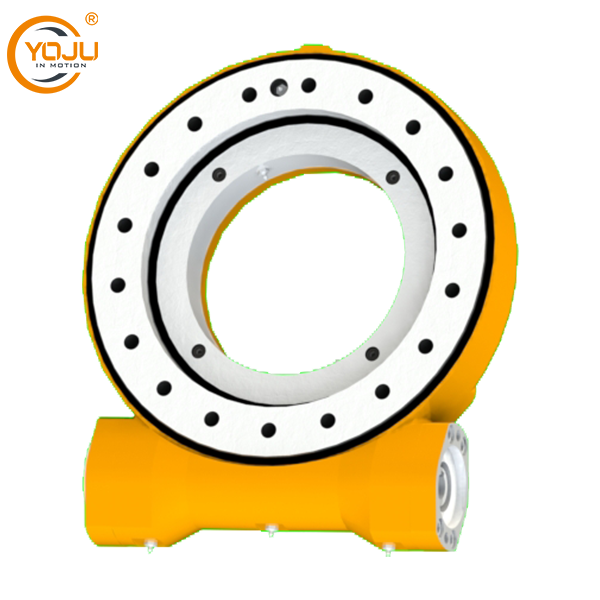Understanding the Role of Slewing Drive in Drilling Machines
In modern industrial drilling systems, the slewing drive for drilling machines plays a pivotal role in enabling precise rotational motion and load control. As drilling applications become more demanding—ranging from foundation engineering to mining and renewable energy projects—the need for compact, high-torque, and durable slewing mechanisms has grown rapidly.
A slewing drive integrates a worm gear, slewing bearing, and housing into a compact structure capable of transmitting torque while supporting axial, radial, and tilting loads. Its function in drilling machines is crucial: it governs the rotation of the drill head or platform, ensuring controlled motion, drilling accuracy, and mechanical stability even under extreme operating conditions. In this blog post, as high precision slew drives manufacturing factory, YOJU will share the advantages of using slewing drives for drilling machines, its key materials, construction, etc.
How Drilling Machine Slewing Drive Operates?
The drilling machine slewing drive mechanism works through a combination of worm gear transmission and slewing bearing integration. The worm shaft drives the gear, creating a self-locking motion that prevents uncontrolled rotation—an essential feature in drilling safety and precision.
In typical rotary drilling rigs, the slewing drive is positioned at the base or the mast, connecting to the rotation system that manipulates the drill head or platform. This configuration allows for smooth, continuous rotation with adjustable torque, accommodating various soil and rock formations.
Moreover, many drilling slewing drives are equipped with hydraulic or electric motors to enable variable speed control, ensuring that drilling parameters can be fine-tuned in real time for optimal performance and energy efficiency.
Advantages of Using Slewing Drive for Drilling Equipment
Integrating a slewing drive in drilling equipment offers a range of engineering and operational advantages:
Compact and Efficient Design:
The integrated worm gear and bearing reduce space requirements, ideal for compact drilling rigs and mobile platforms.High Torque Transmission:
Slewing drives can handle large torque loads, making them suitable for deep or heavy-duty drilling applications.Self-Locking Safety:
The worm gear design provides inherent self-locking capability, preventing reverse rotation when the power source is off—a critical safety factor.Maintenance Simplicity:
With fewer moving parts and sealed housings, slewing drives require minimal maintenance, extending the system’s lifespan.Customizable Configurations:
Manufacturers can design slewing drives in single-axis or dual-axis configurations, adapting to different drilling machine designs and motion requirements.

Types of Slewing Drives Used in Drilling Machines
The choice of slewing drive type for drilling machines depends on the specific application and load profile. Some of the most commonly used configurations include:
Single Worm Slewing Drive: Offers balanced torque control and compact structure for small to mid-sized drilling machines.
Double Worm Slewing Drive: Provides higher torque output and smoother motion, ideal for heavy-duty or large-scale drilling systems.
Enclosed Slewing Drive: Features a sealed housing that protects against dust, mud, and water—perfect for outdoor and construction drilling environments.
Precision Slewing Drive: Utilized in applications where accuracy and repeatability are essential, such as geological survey drilling.
Each type provides specific performance characteristics, allowing engineers to match the slewing drive model with the operational needs of the drilling machinery.
Key Materials and Construction of Drilling Slewing Drives
Durability is fundamental for any slewing drive used in drilling operations, given the harsh environments and heavy mechanical loads involved. These drives are typically constructed using:
High-Strength Alloy Steel: For gears and bearings, providing wear resistance and impact tolerance.
Ductile Iron or Carbon Steel Housing: Ensures structural rigidity and protection from deformation.
Sealed Lubrication Systems: Maintain smooth gear motion and reduce friction under continuous operation.
Additionally, advanced surface treatments such as nitriding or black oxide coating are often applied to enhance corrosion resistance, especially for drives used in offshore or moisture-prone drilling projects.
Applications of Slewing Drive in Modern Drilling Systems
The applications of slewing drive for drilling machinery extend across multiple industrial fields:
Foundation Pile Drilling: For construction of bridges, skyscrapers, and offshore platforms.
Geothermal Drilling: Used in renewable energy exploration, where precision rotation and stability are critical.
Mining and Quarrying: Heavy-duty drives handle large torque and continuous rotation during ore extraction.
Oil and Gas Exploration: Supports controlled directional drilling and rig movement.
Solar Tracking Drilling Rigs: Integrated in rigs used for ground anchoring and solar farm installation.
Each application demands a tailored balance between torque capacity, rotational accuracy, and environmental resilience.
Design Innovations in Slewing Drives for Drilling Machines
Recent advances in drilling slewing drive technology focus on automation, efficiency, and digital integration. Intelligent control systems now enable real-time monitoring of torque, temperature, and vibration, allowing predictive maintenance and reduced downtime.
Hybrid drive designs incorporating hydraulic-electric dual systems offer improved energy efficiency and smoother motion control. Additionally, compact lightweight models are being developed to meet the mobility needs of portable or vehicle-mounted drilling units.
These innovations signify the evolution of slewing drives from purely mechanical components to smart, data-driven systems that enhance drilling precision and sustainability.
Selecting the Right Slewing Drive for Drilling Applications
When choosing a slewing drive for a drilling machine, several parameters must be evaluated:
Load and Torque Requirements: Determine the maximum axial, radial, and tilting load the system must handle.
Rotation Speed: Select gear ratios that achieve the desired drilling speed without compromising stability.
Mounting Orientation: Choose between horizontal or vertical installation based on rig design.
Environmental Conditions: Consider waterproof and dustproof grades (IP65 or higher) for field operations.
Maintenance Accessibility: Ensure that lubrication ports and seals are easily reachable for servicing.
An optimal selection balances mechanical strength, precision, and operational flexibility, maximizing drilling performance and reducing operational costs.
Conclusion
The slewing drive for drilling machines represents a vital link between mechanical engineering precision and field-level performance. As industries move toward intelligent and sustainable drilling practices, slewing drives will continue to evolve—offering higher torque density, smarter control systems, and enhanced material resilience.
From foundation engineering to deep mining, these drives ensure the precision, safety, and reliability that modern drilling operations demand, marking them as indispensable components in the next generation of drilling machinery.
www.enyoju.com
YOJU
